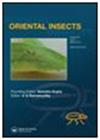斐济蜜蜂现状——地理分布及其在作物授粉中的作用
IF 0.6
4区 农林科学
Q4 ENTOMOLOGY
引用次数: 3
摘要
在过去的十年中,蜜蜂数量的快速下降被认为是由环境变化、栖息地丧失、入侵物种、共同引入的疾病和农业化学品的使用共同驱动的。斐济的本地蜜蜂物种、管理蜜蜂(Apis mellifera)和其他引进蜜蜂物种通过协助作物授粉提供了巨大的经济价值,也有助于维持斐济的植物生物多样性,但它们的数量并不像世界其他地方那样多。然而,最近的科学证据表明,斐济的本地蜜蜂数量和潜在物种在当前和未来也有很大的下降风险。因此,为了有效地保护本地蜜蜂动物群,了解蜜蜂物种的丰富度、多样性和可能的威胁是至关重要的。为了回应过去十年来关于斐济蜜蜂动物群的出版活动,我们回顾了斐济目前发现的蜜蜂物种,它们的地理范围,以及它们与环境的相互作用。我们还讨论了引进蜜蜂的影响和重要性,以及保护方法的相互需要,以确保斐济特有的蜜蜂物种不会被迫灭绝。本文章由计算机程序翻译,如有差异,请以英文原文为准。
Current status of bees in Fiji - geographical distribution and role in pollination of crop plants
ABSTRACT The rapid decline of bee populations over the last decade is thought to be driven by a combination of environmental change, habitat loss, invasive species, co-introduced disease, and chemical use in agriculture. Native bee species, managed honey bees (Apis mellifera), and other introduced bee species in Fiji provide great economic value by assisting in pollination of crops and also contribute to the maintenance of plant biodiversity in Fiji, but do not occur in the high numbers that they can elsewhere in the world. Recent scientific evidence suggests, however, that there is also a high risk of current and future decline in native bee numbers and potentially species in Fiji. Thus, for effective conservation of native bee fauna, knowledge of bee species richness, diversity, and possible threats is critical. In response to a recent flurry of publication activity on the Fijian bee fauna over the last decade, we review the current bee species found in Fiji, their geographical range, and their interactions with the environment. We also discuss the implications and importance of introduced bees and the reciprocal need for conservation methods to be put in place to ensure that the endemic Fijian bee species are not forced into extinction.
求助全文
通过发布文献求助,成功后即可免费获取论文全文。
去求助
来源期刊

Oriental Insects
生物-昆虫学
CiteScore
1.60
自引率
0.00%
发文量
34
审稿时长
>12 weeks
期刊介绍:
Oriental Insects is an international, peer-reviewed journal devoted to the publication of original research articles and reviews on the taxonomy, ecology, biodiversity and evolution of insects and other land arthropods of the Old World and Australia. Manuscripts referring to Africa, Australia and Oceania are highly welcomed. Research papers covering the study of behaviour, conservation, forensic and medical entomology, urban entomology and pest control are encouraged, provided that the research has relevance to Old World or Australian entomofauna. Precedence will be given to more general manuscripts (e.g. revisions of higher taxa, papers with combined methodologies or referring to larger geographic units). Descriptive manuscripts should refer to more than a single species and contain more general results or discussion (e.g. determination keys, biological or ecological data etc.). Laboratory works without zoogeographic or taxonomic reference to the scope of the journal will not be accepted.
 求助内容:
求助内容: 应助结果提醒方式:
应助结果提醒方式:


